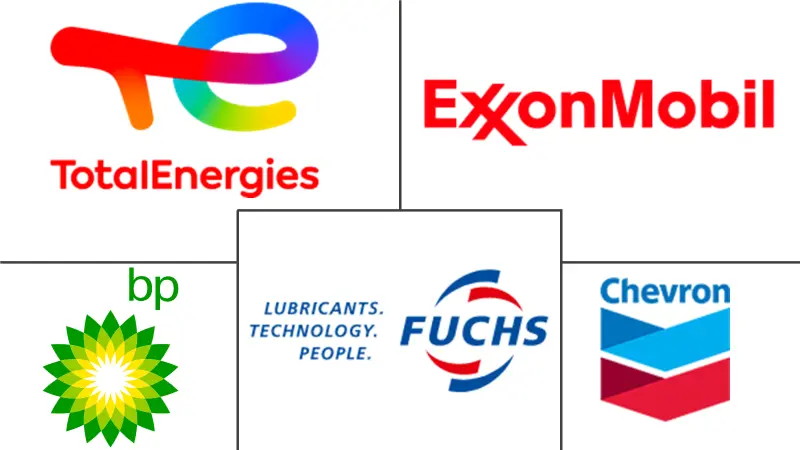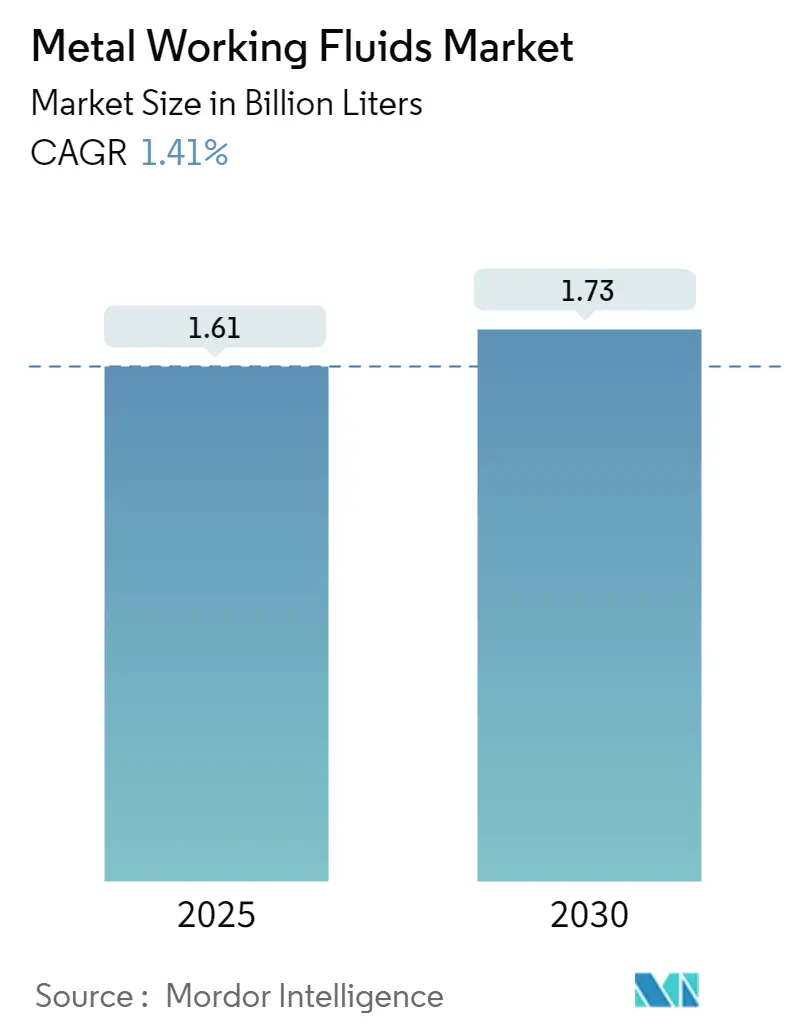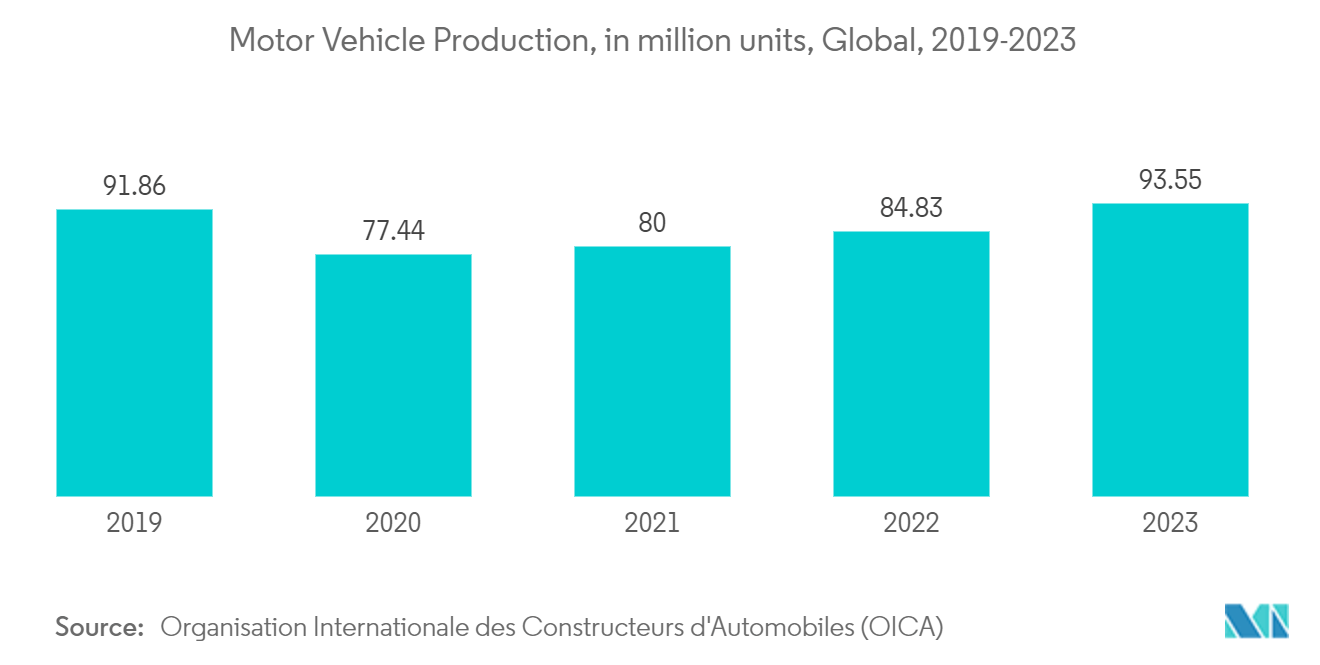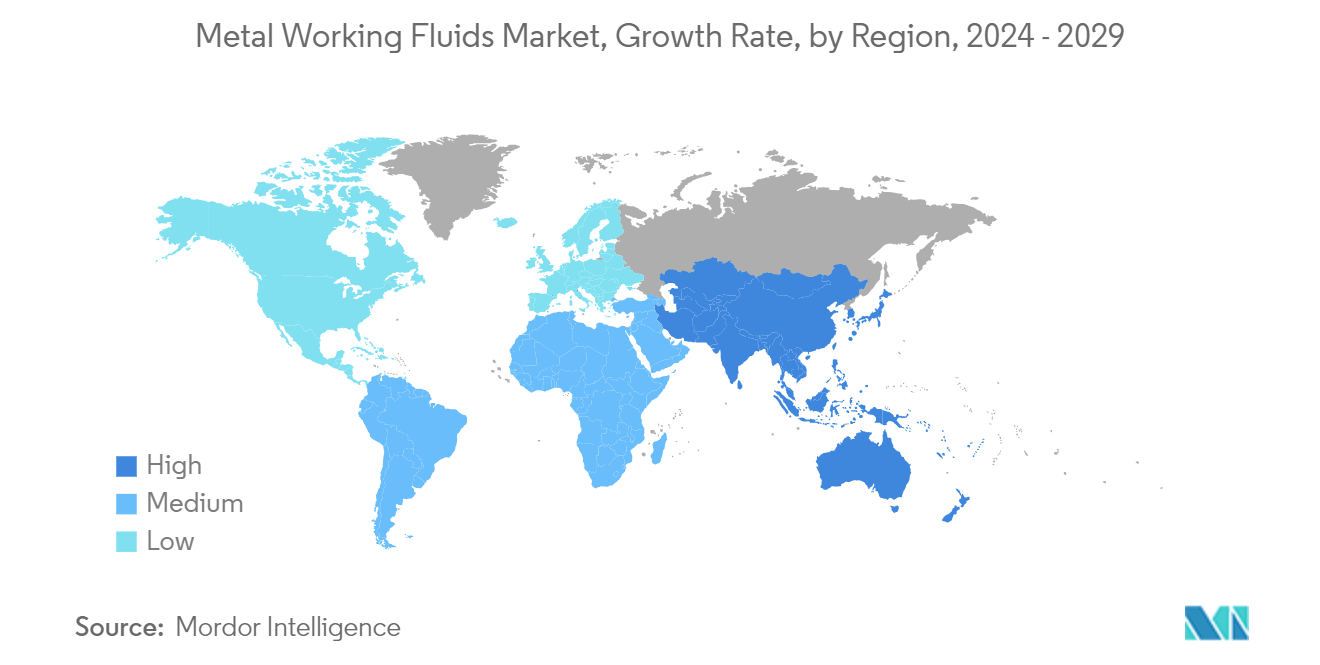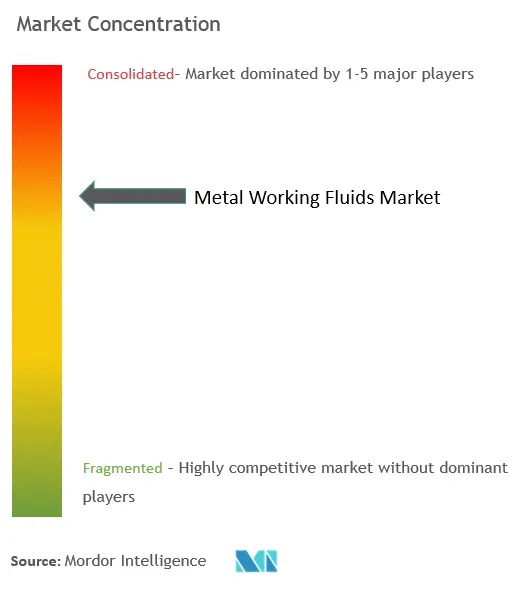Metal Working Fluids Market Analysis
The Metal Working Fluids Market size is estimated at 1.61 billion liters in 2025, and is expected to reach 1.73 billion liters by 2030, at a CAGR of 1.41% during the forecast period (2025-2030).
- The growing demand from the automotive sector and the heavy machinery industry are the major factors driving the demand for metalworking fluids.
- However, the adoption of dry machining technologies and stringent environmental regulations are expected to hinder the market.
- Nevertheless, the emergence of multi-phase metal working fluids and advancements in technology are expected to create new opportunities for the market studied.
- Asia-Pacific dominates the market, with countries like China, India, and Japan being the biggest consumers.
Metal Working Fluids Market Trends
Growing Demand from the Automotive Sector
- Metalworking fluids are crucial in the automotive sector. They reduce friction between tools and workpieces, enhance surface quality, facilitate metal chip removal, and extend tool life. By boosting the efficiency of machining operations, these fluids contribute to heightened machine output.
- According to the Organisation Internationale des Constructeurs d’Automobiles (OICA), in 2023, around 93.55 million units of vehicles were produced worldwide, witnessing a growth rate of around 10.26% compared to 84.83 million units of vehicles in 2022, thereby indicating an increased demand for metalworking fluids from the automotive industry.
- The Asia-Oceania region emerged as the frontrunner in vehicle manufacturing, outpacing other regions. OICA data highlights that automotive production in this region reached 55.11 million units in 2023, up by 10.18% from 50.02 million units in 2022. Notably, this production is spearheaded by key players like China, Japan, South Korea, and India.
- According to the OICA (Organisation Internationale des Constructeurs d'Automobiles), in 2023, China solidified its position as the world's largest automotive production hub, churning out 30.16 million vehicles. This marks a notable 12% uptick from the 27.02 million units produced in 2022.
- Meanwhile, the United States solidified its position as the world's second-largest automotive manufacturer. The automotive sector stands as a cornerstone of the US economy, contributing between 3% and 3.5% to the nation's GDP in 2023. The United States is home to major automakers who not only meet domestic demands but also export vehicles to markets spanning the Americas, Europe, and the Asia-Pacific.
- The Organisation Internationale des Constructeurs d'Automobiles (OICA) reported that the United States produced 10.61 million units of vehicles in 2023, marking a 6% increase from the previous year.
- Europe witnessed a notable growth in motor vehicle production in 2023. Overall, production surged by 13% compared to the previous year. Specifically, passenger car and LCV production saw increases of 12% and 19%, culminating in 15.4 million units and 1.6 million units, respectively, in 2023.
- Given the expanding automotive industry, the demand for metalworking fluids is poised to rise during the forecast period.
Asia-Pacific to Witness the Fastest Growth
- Asia-Pacific leads the market, driven by rising demand from the automotive and heavy machinery and equipment sectors. Countries like China, India, and Japan are witnessing a surge in their heavy machinery industry, fueled by industrialization and economic growth.
- Metalworking fluids play a crucial role in manufacturing heavy machinery and equipment.
- The heavy machinery industry encompasses diverse sub-sectors, including machine tools, heavy electrical equipment, cement machinery, material handling, plastics processing, process plant equipment, and equipment for earth moving, construction, and mining.
- China's 14th Five-Year Plan aims to bolster its agricultural and rural transformation, which is directly related to the heightened use of heavy machinery in agriculture and construction.
- China's agricultural equipment sector has been on a steady upward trajectory, featuring close to 10,000 farming machinery firms and over 20,000 distribution entities. As highlighted by AgroPages in 2023, amidst 14 foreign trade sub-sectors, agricultural machinery exports showcased a robust 33.5% year-on-year surge, particularly in large and medium-sized tractors.
- Moreover, data from the China Construction Machinery Association (CCMA) indicates a 5.31% year-on-year rise in excavator sales, totaling 16,603 units in June 2024. Domestic sales reached 7,661 units, reflecting a strong 25.6% annual growth.
- India's agricultural equipment sector holds immense weight in the global arena, with numerous Indian manufacturers catering to both domestic and international markets. The Tractor Manufacturers Association reported a 19.24% dip in tractor sales in December 2023, with figures dropping from 55,390 units in 2022 to 44,735 units. However, overseas exports remained robust at 96,223 units in 2023, albeit down from 131,850 units in 2022.
- The Indian construction equipment industry experienced a 26% growth in the fiscal year 2023-24, largely due to the government's infrastructure-driven agenda. According to the Indian Construction Equipment Manufacturers' Association (ICEMA), 2023 sales reached 135,650 units, up from 107,779 units the previous year. Notably, earthmoving equipment sales, the industry's largest segment, rose by 21% to 93,531 units in FY 2023-24, constituting about 70% of the total sales.
- Passenger vehicle sales in India jumped 23% in the financial year 2023, as reported by the Federation of Automobile Dealers Associations. Leading manufacturers navigated intermittent supply chain challenges, particularly with semiconductors and electronics. Driven by rising disposable incomes, a wave of new sport-utility vehicles, and attractive loan rates, India's passenger vehicle sales touched 4 million units for the first time in FY 2023.
- According to the Society of Indian Automobile Manufacturers (SIAM), in 2023, sales of cars, sedans, and utility vehicles surpassed 4.1 million. This marks an 8.2% rise from the 3.79 million sold in 2022. The surge was predominantly fueled by utility vehicles, making up 57.4% of the total sales.
- Given these dynamics, Asia-Pacific is poised to lead the metalworking fluids market in the coming years.
Metal Working Fluids Industry Overview
The metal working fluids market is partially consolidated in nature. The major players (not in any particular order) include Exxon Mobil Corporation, FUCHS, TotalEnergies, BP PLC, and Chevron Corporation.
Metal Working Fluids Market Leaders
-
Exxon Mobil Corporation
-
FUCHS
-
TotalEnergies
-
BP p.l.c.
-
Chevron Corporation
- *Disclaimer: Major Players sorted in no particular order
Metal Working Fluids Market News
- September 2023: FUCHS Group inaugurated a state-of-the-art facility in Ba Ria-Vung Tau, Vietnam, with an investment of EUR 9 million (USD 9.52 million). The plant's production range includes automotive oils, industrial oils, metalworking fluids, and specialized solutions for the mining sector. This strategic investment positions FUCHS Vietnam to swiftly address the growing lubricant demands in the region.
- February 2023: Univar Solutions Inc. secured exclusive distribution rights for Automate's oil-based dyes and authorized distribution rights for water-based dyes. These agreements cater specifically to customers in lubricants and metalworking fluids across the United States and Canada. This new agreement enhances Univar Solutions' specialty ingredients portfolio, offering products designed for diverse applications in lubricant, oil, grease, and fuel coloration.
Metal Working Fluids Industry Segmentation
Metalworking fluids (MWFs) encompass oils and liquids crucial for cooling and lubricating metal workpieces during machining, milling, and grinding processes. These fluids mitigate heat and friction, thereby averting burning and smoking. Moreover, they enhance workpiece quality by effectively clearing fines, chips, and swarfs from both the tool and the workpiece surface.
The metal working fluids market is segmented by product type and geography. By product type, the market is segmented into removal fluids, forming fluids, protection fluids, and treating fluids. By geography, the market is segmented into Asia-Pacific, North America, Europe, South America, and the Middle East and Africa. The report also covers the market size and forecasts for the metalworking fluids market in 27 major countries across major regions. For each segment, the market sizing and forecasts have been done on the basis of value (USD).
| By Product Type | Removal Fluids | ||
| Forming Fluids | |||
| Protection Fluids | |||
| Treating Fluids | |||
| By Geography | Asia-Pacific | China | |
| India | |||
| Japan | |||
| South Korea | |||
| Malaysia | |||
| Thailand | |||
| Indonesia | |||
| Vietnam | |||
| Rest of Asia-Pacific | |||
| North America | United States | ||
| Canada | |||
| Mexico | |||
| Europe | Germany | ||
| United Kingdom | |||
| France | |||
| Italy | |||
| Spain | |||
| NORDIC Countries | |||
| Turkey | |||
| Russia | |||
| Rest of Europe | |||
| South America | Brazil | ||
| Argentina | |||
| Colombia | |||
| Rest of South America | |||
| Middle East and Africa | Saudi Arabia | ||
| Qatar | |||
| United Arab Emirates | |||
| Nigeria | |||
| Egypt | |||
| South Africa | |||
| Rest of Middle East and Africa | |||
Metal Working Fluids Market Research FAQs
How big is the Metal Working Fluids Market?
The Metal Working Fluids Market size is expected to reach 1.61 billion liters in 2025 and grow at a CAGR of 1.41% to reach 1.73 billion liters by 2030.
What is the current Metal Working Fluids Market size?
In 2025, the Metal Working Fluids Market size is expected to reach 1.61 billion liters.
Who are the key players in Metal Working Fluids Market?
Exxon Mobil Corporation, FUCHS, TotalEnergies, BP p.l.c. and Chevron Corporation are the major companies operating in the Metal Working Fluids Market.
Which is the fastest growing region in Metal Working Fluids Market?
Asia Pacific is estimated to grow at the highest CAGR over the forecast period (2025-2030).
Which region has the biggest share in Metal Working Fluids Market?
In 2025, the Asia Pacific accounts for the largest market share in Metal Working Fluids Market.
What years does this Metal Working Fluids Market cover, and what was the market size in 2024?
In 2024, the Metal Working Fluids Market size was estimated at 1.59 billion liters. The report covers the Metal Working Fluids Market historical market size for years: 2019, 2020, 2021, 2022, 2023 and 2024. The report also forecasts the Metal Working Fluids Market size for years: 2025, 2026, 2027, 2028, 2029 and 2030.
Our Best Selling Reports
Metal Working Fluids Industry Report
The global metalworking fluids market is experiencing significant growth, driven by diverse industrial demands and regional expansions, particularly in the Asia-Pacific region. The market is segmented based on product types, including mineral, synthetic, and bio-based fluids, with mineral oils holding a substantial share due to their cost-effectiveness. Applications such as neat cutting oils and water cutting oils are categorized, with neat cutting oils dominating due to their extensive use in various machining processes. Key end-use industries like machinery, transportation equipment, and construction are major contributors to the market's expansion. The machinery segment is witnessing robust growth due to increased demand for agricultural and construction equipment, while the transportation equipment segment is also expected to see significant growth. Industrial end-users such as construction and automobile sectors are pushing the demand for metalworking fluids, with the construction segment leading due to rising global urbanization and infrastructure projects. The automobile industry is anticipated to grow rapidly, fueled by increasing luxury car sales and advancements in manufacturing processes that require high-quality metalworking fluids. For detailed statistics and a market forecast outlook, refer to Mordor Intelligence™ Industry Reports, which provide a comprehensive historical overview and a free report PDF download.

